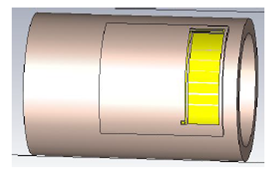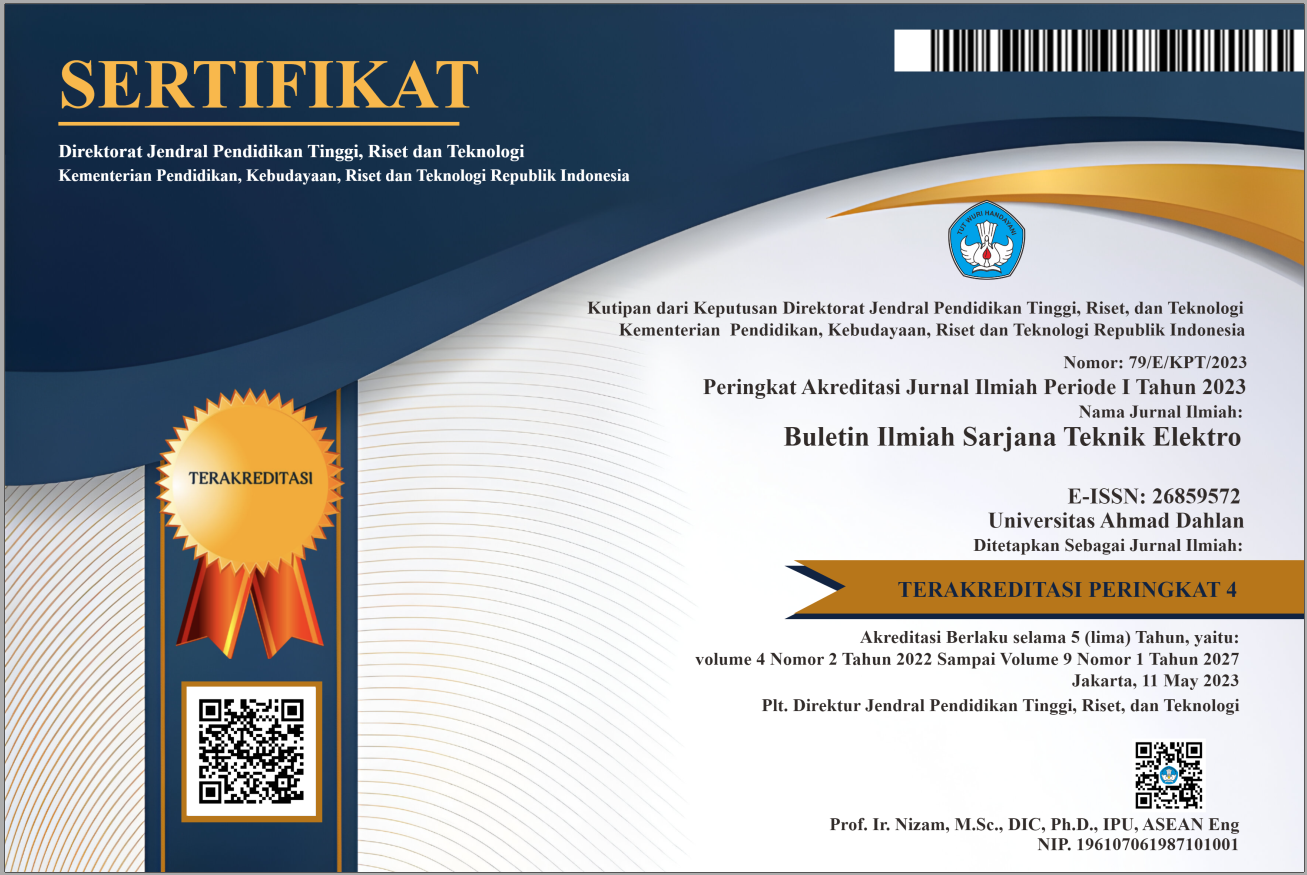Design of PIFA Antenna Using Systematic Tuning for Long Range Communication
DOI:
https://doi.org/10.12928/biste.v5i4.9844Keywords:
PIFA, Conformal, Tunning, 900 MHz, Long RangeAbstract
Communication with a wireless system is one of the mainstays of communication so that communication integration is achieved. In this application, of course, an antenna is needed to send information waves to the receiver. It is also hoped that the antenna can be integrated with other components into an integrated system. There are several challenges that need to be answered to make this happen. Namely, the size of the antenna is small and the shape of the antenna can adjust to the shape of the object being integrated, for example a circle or cylinder shape. The antenna chosen to realize this challenge is the Planar Inverted F Antenna (PIFA). PIFA antennas are widely used in communication devices because their shape and size can be adjusted to the dimensions of the device. The technique used to create curved shapes is a conformal technique. To streamline the antenna design steps, the system tuning method is applied when simulating the design. The results achieved use a system tuning method which can reduce the experimental steps to just 6 experimental steps. The antenna designed works in the frequency range 916.9 – 933 MHz, the resonant frequency of 925.6 MHz with S11 is -12.5 dB, bandwidth 16.1 MHz, and the radiation pattern is omnidirectional.
References
I. F. Akyildiz, A. Kak, and S. Nie, “6G and Beyond: The Future of Wireless Communications Systems,” IEEE Access, vol. 8, pp. 133995–134030, 2020, https://doi.org/10.1109/ACCESS.2020.3010896.
Q. Wu, “4G Communication Technology Wireless Network Secure Communication,” 2021 Int. Wirel. Commun. Mob. Comput. IWCMC 2021, pp. 915–918, 2021, https://doi.org/10.1109/IWCMC51323.2021.9498797.
M. Islam and S. Jin, “An Overview Research on Wireless Communication Network,” Adv. Wirel. Commun. Networks, vol. 5, no. 1, p. 19, 2019, https://doi.org/10.11648/j.awcn.20190501.13.
S. Alfattani, “Review of LiFi Technology and Its Future Applications,” J. Opt. Commun., vol. 42, no. 1, pp. 121–132, 2021, https://doi.org/10.1515/joc-2018-0025.
H. Karami, H. Tabarsa, G. B. Gharehpetian, Y. Norouzi, and M. A. Hejazi, “Feasibility study on simultaneous detection of partial discharge and axial displacement of HV transformer winding using electromagnetic waves,” IEEE Trans. Ind. Informatics, vol. 16, no. 1, pp. 67–76, 2020, https://doi.org/10.1109/TII.2019.2915685.
S. Ghosh and D. Sen, “An Inclusive Survey on Array Antenna Design for Millimeter-Wave Communications,” IEEE Access, vol. 7, pp. 83137–83161, 2019, https://doi.org/10.1109/ACCESS.2019.2924805.
K. Kundu, A. Dubey, A. Dhama, and N. N. Pathak, “Planar inverted F antenna, PIFA array in 5G applications,” In Journal of Physics: Conference Series, vol. 2062, no. 1, p. 012002, 2021, https://doi.org/10.1088/1742-6596/2062/1/012002.
M. Ikram, Y. Wang, M. S. Sharawi, and A. Abbosh, “A novel connected PIFA array with MIMO configuration for 5G mobile applications,” 2018 Aust. Microw. Symp. AMS 2018 - Conf. Proc., vol. 2018-Janua, pp. 19–20, 2018, https://doi.org/10.1109/AUSMS.2018.8346961.
K. Kundu, A. Dubey, A. Dhama, and N. N. Pathak, “Planar inverted F Antenna, PIFA array in 5G applications,” J. Phys. Conf. Ser., vol. 2062, no. 1, 2021, https://doi.org/10.1088/1742-6596/2062/1/012002.
S. S. Md. Enan, A. Istiaque and M. A. Hossain, "Design and Characterization of Miniaturized Implantable PIFA Antenna for MICS Band Application," 2020 IEEE Region 10 Symposium (TENSYMP), pp. 254-257, 2020, https://doi.org/10.1109/TENSYMP50017.2020.9230999.
M. Nahas, “A Super High Gain L-Slotted Microstrip Patch Antenna For 5G Mobile Systems Operating at 26 and 28 GHz,” Eng. Technol. Appl. Sci. Res., vol. 12, no. 1, pp. 8053–8057, 2022, https://doi.org/10.48084/etasr.4657.
A. Ahmadihaji, H. Aliakbarian, N. M. Saaid, and P. J. Soh, “Design, simulation, fabrication and evaluation of a textile pifa for wearable iot application,” ECTI Trans. Comput. Inf. Technol., vol. 15, no. 3, pp. 289–302, 2021, https://doi.org/10.37936/ecti-cit.2021153.241779.
R. Kumar, L. S. Solanki, and S. Singh, “Miniature Archimedean Spiral PIFA Antennas for Biomedical Implantable Devices,” 2019 6th Int. Conf. Signal Process. Integr. Networks, SPIN 2019, no. 2, pp. 162–167, 2019, https://doi.org/10.1109/SPIN.2019.8711600.
R. Del-Rio-Ruiz, J. M. Lopez-Garde, and J. Legarda, “Planar textile off-body communication antennas: A survey,” Electron., vol. 8, no. 6, 2019, https://doi.org/10.3390/electronics8060714.
S. Costanzo and A. M. Qureshi, “Compact and wideband PIFA design for wireless body area sensor networks,” Electron., vol. 10, no. 21, 2021, https://doi.org/10.3390/electronics10212576.
G. Gao, S. Wang, R. Zhang, C. Yang, and B. Hu, “Flexible EBG-backed PIFA based on conductive textile and PDMS for wearable applications,” Microw. Opt. Technol. Lett., vol. 62, no. 4, pp. 1733–1741, 2020, https://doi.org/10.1002/mop.32224.
P. D. P. Adi and A. Kitagawa, “Performance evaluation of E32 long range radio frequency 915 MHz based on internet of things and micro sensors data,” Int. J. Adv. Comput. Sci. Appl., vol. 10, no. 11, pp. 38–49, 2019, https://doi.org/10.14569/IJACSA.2019.0101106.
A. Ikpehai et al., “Low-power wide area network technologies for internet-of-things: A comparative review,” IEEE Internet Things J., vol. 6, no. 2, pp. 2225–2240, 2019, https://doi.org/10.1109/JIOT.2018.2883728.
N. Islam, B. Ray, and F. Pasandideh, “IoT Based Smart Farming: Are the LPWAN Technologies Suitable for Remote Communication?,” Proc. - 2020 IEEE Int. Conf. Smart Internet Things, SmartIoT 2020, pp. 270–276, 2020, https://doi.org/10.1109/SmartIoT49966.2020.00048.
M. A. Jamshed, A. Nauman, M. A. B. Abbasi, and S. W. Kim, “Antenna Selection and Designing for THz Applications: Suitability and Performance Evaluation: A Survey,” IEEE Access, vol. 8, pp. 113246–113261, 2020, https://doi.org/10.1109/ACCESS.2020.3002989.
L. Dai et al., “Reconfigurable Intelligent Surface-Based Wireless Communications: Antenna Design, Prototyping, and Experimental Results,” IEEE Access, vol. 8, pp. 45913–45923, 2020, https://doi.org/10.1109/ACCESS.2020.2977772.
M. Z. Chowdhury, M. Shahjalal, S. Ahmed, and Y. M. Jang, “6G Wireless Communication Systems: Applications, Requirements, Technologies, Challenges, and Research Directions,” IEEE Open J. Commun. Soc., no. i, 2020, https://doi.org/10.1109/OJCOMS.2020.3010270.
S. Kumar et al., “A 915 MHz Wristwatch-Integrated Antenna for Wireless Health Monitoring,” 14th Eur. Conf. Antennas Propagation, EuCAP 2020, 2020, https://doi.org/10.23919/EuCAP48036.2020.9135360.
T. N. Kapetanakis et al., “Embroidered bow-tie wearable antenna for the 868 and 915 mhz ism bands,” Electron., vol. 10, no. 16, pp. 1–14, 2021, https://doi.org/10.3390/electronics10161983.
J. Gui, A. Andújar, and J. Anguera, “On the Reuse of a Matching Network for IoT Devices Operating at 900 MHz Embedding Antenna Boosters,” Electron., vol. 11, no. 8, 2022, https://doi.org/10.3390/electronics11081267.

Published
How to Cite
Issue
Section
License
Copyright (c) 2023 Liya Yusrina Sabila, Teguh Prakoso, Munawar Agus Riyadi

This work is licensed under a Creative Commons Attribution-ShareAlike 4.0 International License.
Authors who publish with this journal agree to the following terms:
- Authors retain copyright and grant the journal right of first publication with the work simultaneously licensed under a Creative Commons Attribution License that allows others to share the work with an acknowledgment of the work's authorship and initial publication in this journal.
- Authors are able to enter into separate, additional contractual arrangements for the non-exclusive distribution of the journal's published version of the work (e.g., post it to an institutional repository or publish it in a book), with an acknowledgment of its initial publication in this journal.
- Authors are permitted and encouraged to post their work online (e.g., in institutional repositories or on their website) prior to and during the submission process, as it can lead to productive exchanges, as well as earlier and greater citation of published work (See The Effect of Open Access).
This journal is licensed under a Creative Commons Attribution-ShareAlike 4.0 International License.


